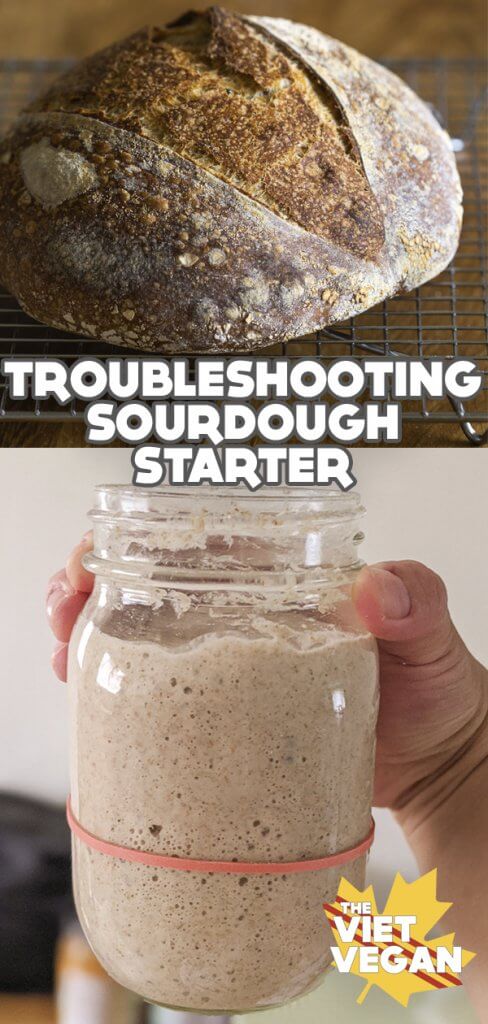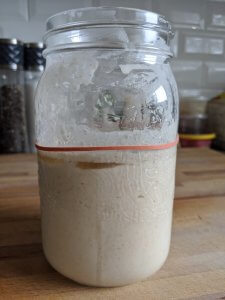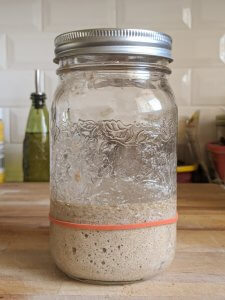
If you’ve been following me on Instagram at all, you know I’ve been diving head-first into sourdough and had a pretty long and complicated journey for Carter the Starter. The beginnings were a little rough, but I came out in the end with a stubbornly strong starter who has helped me bake some beautiful loaves of bread and other delicious creations. Today’s blog post is about troubleshooting sourdough starter, and seeing the different issues I had with Carter and how I managed to read them and learn how to adjust.
When I was first starting this sourdough journey, I was just using all purpose flour (as per King Arthur Flour), but I found that starting off from whole wheat flour and then just switching to AP flour shocked my starter and he was having a hard time recognizing AP flour as food. As a result, my friend Liz sent me a schedule to wean my starter onto a mix of whole wheat flour and AP flour. It took a while to re-balance Carter and get him accustomed to the new food, but once he got going, he couldn’t stop.
But before I managed to get him going, I came across a few issues first. But before I get into troubleshooting sourdough starter:
Basic tips I learned are important for sourdough starter:
- You want a warm environment. Ideally 23-25C (or 73-77F).
- If it’s colder, like 21C, it’ll still work but your starter will be a bit slower.
- Any hotter, and you’ll find your timeline a bit more accelerated. Not a bad thing! You’ll just have to increase your feeding schedule.
- Use unbleached flour. Ideally organic!
- You want wild yeast in the flour, and that won’t exist in bleached flour.
- Use filtered water or boiled water that has cooled down.
- You can use tap water, but depending on where you live, it can be chlorinated and that isn’t good for the starter.
- Get a kitchen scale.
- Lots of sites have sourdough starter tutorials using tablespoons and saying “discard half” and what not, but a scale eliminates any unknown factors when it comes to amounts because weight is so much more accurate and consistent than volume.
- When in doubt, just keep feeding.
- There is always going to be activity happening with the starter, whether you can see it or not. The beginning stages might not be that exciting, but keep feeding and you’ll eventually get that exciting rise in activity where it doubles past your rubber band!
- Use the same flour blend to feed your starter that you used to create it.
- If I were to do this all over again, I’d probably just start off the bat with a flour mix of 2:1:1 (rye:whole wheat:all purpose) so I could skip the whole weaning process (outlined in the recipe below)
So now that we’ve got those basics established, let’s get into troubleshooting sourdough starter!
What is this liquid on top of my sourdough starter?

This photo is from the morning of day 3: At the time, I went from feeding my 100% whole wheat starter to taking out half, then adding 113 g organic, unbleached all purpose flour. Immediately I started to notice that the smell was pretty acidic, almost alcoholic, and there was a clear, dark liquid on top.
I’ve read in some articles that say to stir it in, and some others say to pour it off. I decided to pour it off because it’s the by-product of digested yeast, and frankly it kinda stinks. There was plenty of food for my starter, but you can see that he rose maybe about 10% of his original height, then deflated pretty quickly. I attribute this to the fact that Carter didn’t really recognize all purpose flour as food yet since he started off as a whole wheat starter.
The wonderful Liz Miu, aka Miss Sourdough Extraordinaire, helped me by explaining that he was a bit shocked, and sent me huge schedule of different flour amounts to slowly wean my starter onto AP flour. The point of weaning Carter (or any starter) onto AP flour is because the majority of sourdough recipes are made with white bread flour or AP flour. Plenty of bread recipes use a blend of various different whole grains, but if I were planning on baking with a recipe that is 70% all purpose of white bread flour, I should have a starter that will readily digest it, which will yield a properly risen bread.
So if you find your starter has this dark liquid on top, don’t fret! Don’t throw it away. Simply pour it off (as much as you can anyway), take out half, and feed your starter. If you see this happening at the 24hr mark of your sourdough journey, it’s a sign that your starter is hungry and needs to be fed more often. When this happened, I switched to a 12 hour feed (and there was a point in the summer I had to go to an 8 hour feed because it was happening at 12 hrs too).
My sourdough starter smells like paint thinner/dirty socks? WTF?
Similarly to the liquid on top of the starter issue, I found that my starter smelled pretty funky (and not in a good way) when it was hungry. If there’s liquid on top, pour it off, that’s the cause of the smell and is simply the byproduct of digested yeast/bacteria. It’s a good thing actually! Then you know that it’s active in there, it just need to be balanced. If there’s more bacteria or more yeast, sometimes the smell will be a little funky and it won’t start smelling pleasantly tart and sour until things balance out. Keep feeding at regular intervals (12 hrs typically) and use a rubber band to track the growth. Your starter should be doubling in size at its peak around 6-8 hrs after a feed, the deflate about 20-30% from the peak around 12 hrs.
My sourdough starter smells like bananas?
I found that my sourdough starter would smell like bananas around day 4 or 5, as well as after I took him out of the fridge when he was fully built up. When I looked this up, I found out that sourdough starter smells like bananas when there are more esters present. This is just part of the process of re-balancing the sourdough starter and it means it isn’t quite ready for baking yet. Trust me, I tried baking with a levain I built from a banana-smelling starter, and it yielded some pretty disappointing frisbee loaves. They were tasty, but didn’t really rise in the fridge much at all, and were pretty difficult to handle during the stretch/fold and shaping process.
In any case, the solution is to keep feeding. It will balance itself out eventually!
My sourdough doesn’t look like it’s doing anything…

In the early days of getting my sourdough starter going, my sourdough starter was barely rising, had a couple bubbles here and there, but wasn’t doubling in size the way it was supposed to. But it’s okay! The yeast and bacteria in the starter are duking it out and trying to find harmony to create that pleasantly tart and fruity-smelling sourdough starter, so it just needs a bit of time. Just keep feeding every 12 hours.
The secret to getting my sourdough starter going?
Rye flour!
So many of you have confirmed that rye flour was the game-changer for your starters as well, but Carter was chugging along before with whole wheat and all-purpose, but then started to explode with activity as soon as I introduced rye flour. I introduced rye at 10g in the beginning (so 10g of the total 100g that I had been feeding him) and ever since, he’s been super happy and active. I’ve gradually increased my flour mix to 50% rye and Carter has been thriving on it! Most people I know who used rye from the get-go didn’t have as many issues with their starter as those who didn’t. I think there’s something about the type of yeast and bacteria that lives on rye flour that makes it so good for sourdough starters!
My starter is using too much flour! This is so expensive!
Yep. It can certainly be pricey after a while, especially if you’re not baking every day. Feeding an active sourdough starter twice a day can eat through your flour reserves pretty quickly. First of all, I would recommend scaling down the amount of starter you are feeding down to 10 g, 5 g or even 1 g.
I currently feed my sourdough at a 1:5:4 ratio (so 5 g starter, 25 grams flour mix, 20 g cold filtered water). The King Arthur Flour tutorial I was using for sourdough had me using 113 g of flour per feeding, so 226 g of flour a day, which is an unreal amount of flour. I think if I were to do this again, I’d start off with a smaller amount, like either 50 g each, or even 25 g flour and 25 g water, because the bacteria and yeast are still there, I’d just rather go by a smaller increments to build up the starter. It should take the same amount of time, it’ll just be less waste over all.
Another way to stop using as much flour is to stop feeding as much if you’re not baking every day! Slow down that feeding cycle by putting your starter in the fridge. I put Carter in the fridge after feeding whenever I’m not going to bake. This will make your starter go dormant and will slow the feeding/activity schedule.
Depending on your starter, you may need to feed once every 2 days, or once a week. There are tons of people who have forgotten their starter in the fridge for a year, and with no sign of mold, they started to refeed again and the starter came back to life! Starters are surprisingly resilient.
How do I bake from my starter in the fridge?
Once you take your sourdough starter out of the fridge, you’ll want to give it a couple feedings before it’s ready again. Typically I’ll put Carter in the fridge on Sunday night, and if I want to bake on a Saturday, then on Thursday night, I’ll take him out of the fridge, pour off any liquid, then resume the 12 hr feeding schedule to get him going again. I have a more detailed post about this and how to know when you can bake with your starter again! Check it out here.
My recipes made with discard are making me super bloated and gassy?!
When I started out, I wanted to reduce the amount of food waste by eating the discard from the beginning of my starter. However, at the beginning, the balance of yeast and bacteria is a little out of whack so your body might not be able to handle that, hence the bloating and gassiness. I stopped eating anything baked with my discard until it was fully mature (predictably rising and falling at 12 hrs, and smelling pleasant and tart). Luckily you can compost your discard so I highly recommend doing that until you can eat it!
I feel wasteful discarding this much starter every day!
Once you have a mature starter, you’ll find yourself with an abundance of discard and it adds up over time. Some people say not to bother discarding at all, but the point of discarding starter is to reduce the amount of starter you need to feed. Contrary to how to seems, discarding is to reduce waste!
I started storing my discard into a jar to keep in the fridge and would just keep saving it up until I had enough for a larger recipe I wanted to bake with (some of the bigger recipes call for 100g of discard). When it’s refrigerated, it’s not quite as active or reliable to bake a sourdough boule with, but it works fine for pancakes, banana bread, cookies, crackers, or cinnamon rolls. I don’t have any specific recipes for those yet, I’ve mostly been relying on sites like The Clever Carrot to guide me since I’m only about a few weeks into having a fully mature sourdough starter. I have been veganizing and playing around with certain recipes though, so maybe eventually I’ll start feeling confident enough to post those!
Now that I finally have a mature sourdough starter, I’ve been baking bread 2-3 times a week! I can’t stop, it’s just so exciting and rewarding (although Eddie isn’t really as into sourdough as I am so I should really slow down ahha). I’ve shared below my “recipe” for sourdough starter, but it is by no means what you should be doing. Honestly if I were to do this all over again, I’d just use a flour mix of 2:2:1 (rye: bread flour: whole wheat) and not bother with the weaning of ap flour or any of that.
It took me about 3 weeks to get my starter fully mature, and I waited about 2 weeks before I attempted a boule because I was too afraid to fail haha. I had been baking focaccia and had some pretty epic failures, but eventually got it right! I should share my version of sourdough focaccia (it’s based off of Liz Miu’s recipe!), but I’ll have to do that once I’m done being excited about sourdough haha. Sorry! We can only eat so much bread XD
Anyway, for posterity and for you to see what I did, here’s how I started Carter the Starter (with notes on what I wish I had done differently). I hope this deep dive into troubleshooting sourdough starter is helpful and that I can save you some flour along the way haha.
Sourdough Starter
Ingredients
To begin the starter:
- 100 g whole wheat or wholemeal rye flour
- 100 g water
Day 2-5:
- 70 g of previous starter
- 100 g whole wheat flour/Rye flour
- 115 g water
Day 6 – Weaning onto AP flour:
- 70 g previous starter
- 90 g Whole Wheat/Rye flour
- 10 g all purpose flour unbleached and ideally organic
- 115 g water
Day 7-8
- 70 g of previous starter
- 75 g Whole Wheat/Rye flour
- 25 g All purpose Flour
- 115 g water
Day 9-10:
- 50 g of previous starter
- 50 g Whole Wheat/Rye
- 50 g All purpose flour
- 100 g water
Day 11+ – Maintaining the Starter:
- 25 g of previous starter
- 50 g Whole Wheat/Rye flour
- 50 g All purpose flour
- 100 g water
My current feed (for 80% hydration to slow down the starter)
- 5 g of previous starter
- 25 g flour mix 2:1:1 of rye : whole wheat : all purpose flour
- 20 g water
Instructions
- To begin the starter:In a tall glass jar like a 1-pint or 1 L mason jar, combine whole wheat flour and water. If I were to do this all over again I’d probably just do a combo of both instead of just whole wheat because rye was the game-changer for my starter to be consistently active and strong.
- I mixed well to ensure the flour is completely hydrated, used a spatula to scrape down the sides, and used a rubber band to track where the mixture begins so I could track how much it expanded. I covered loosely with a lid (these days I just use a silicone lid) and let sit at room temperature for 24 hours.
- Day 2-5 of Refreshing + Building Starter:I started to see activity almost immediately, but this is just the beginning of capturing the yeast so I discarded about half (I use a new jar and add 70 g of the previous starter to it, then discard the contents of the old jar), and then added AP flour and water (as per the King Arthur Flour recipe). This caused my starter to freak out because I just shocked it with completely different flour, so if I were to do this again, I’d use the amounts listed in the ingredients for this stage. Anyway, at the time, I stirred to combine, ensuring all flour is hydrated. Scraped down the sides with a spatula, added a rubber band to track growth, covered loosely with a lid and let set for 24 hrs.
- Once I started to see my starter deflate around 12 hours, I switched to 12 hour feedings instead of 24 hrs. For you, this could happen on day 3, or day 5, you will just have to watch to see the activity.
- The easiest sign is if you see a clear, almost alcoholic liquid on top, that means your starter has eaten through all the flour and is releasing that alcoholic liquid. Pour off that clear liquid (also called hooch), then increase your feeding schedule to every 12 hours, using the same amounts in the ingredients, only increasing in frequency. My starter started smelling sort of tart and fruity, and then kinda alcoholic/paint thinner (because he was hungry), then kind of like bananas, and finally once the balance of yeast was setting, he started to actually smell like traditional sourdough bread!
- Day 6 – Weaning onto AP flour:Once my starter was established and healthy, I wanted to wean it onto AP flour so it’d proof well in most sourdough recipes (as most call for AP flour). Liz Miu outlined this schedule to wean my starter onto the new feed.
- I took 70 g of the previous starter (discarding the remainder), then added 90 g Whole Wheat/Rye flour (I recommend a 50/50 mix), and 10 g flour, then add 115 g water. Again, mixed well to ensure all is hydrated. Scraped down sides, cover edloosely, and marked the growth with a rubber band. Let rest for 12 hours, then repeated the discarding and feeding amounts again. Covered loosely, marked with rubber band, yada yada.
- Day 7-10:I repeated the same discard and feeding schedule at 12 hours, but the amounts transitioned to my current feed as I was slowly reducing hydration and weaning the starter onto all purpose flour. Use the amounts as per the ingredient list.
- Day 11+:At this point, you’ve got your ratio down to 1:4:4 (1 part starter, to 4 parts flour mix and 4 parts water). This is the maintenance for a super strong basic starter, and I found myself feeding every 12 hours when it was normal, coolish weather (18 C). That’s it! My starter at this point was ready to bake with.
- However, once the summer days started rolling, I found my starter SUPER active and eating through all the food at around 8 hours, so I switched to an 8 hour feeding schedule. I then switched my feed to a lower hydration level (listed at "My Current Feed") to slow down the feeding schedule, and eventually reduced it down to a microfeed of 5 g starter, 25 g flour mix, and 20 g water, so I could stop using as much flour.



Eric says
I came across this site after my sour dough starter began to smell like bananas . Lucky I didn’t throw it away! This site is very well written and the easiest to understand that I’ve come across. This beginner thanks you !
Lisa Le says
I’m so glad it was helpful!
J says
Hi. Is there a chance you have a step by step guide to make the starter? I’ve never made one before. Thanks!
Lisa Le says
My step by step for how I made my starter is below :) I’ve only made the one so my roundabout journey is how I got there, but I’ve written notes about what I’d do differently if I had to start again!
J says
Thank you!
This is my second attempt and on Day 2 I got some rising!
I do think the magic is rye flour
Lisa Le says
I’m so glad!! Yes honestly rye has been the secret sauce for so many people
Polina says
Hello Lisa!
Is it ok that at first day my starter get very dry ball of dough?
Lisa Le says
Hmm maybe add more water. It should be like a very thick batter!
Olga says
What is the ‘crust’ on top of my starter?
Lisa Le says
Probably dried out starter? Do you put a lid on it?